Management Accounting Report: Financial Analysis of Airdri (BTEC)
VerifiedAdded on 2023/01/13
|15
|3799
|1
Report
AI Summary
This report provides a comprehensive analysis of management accounting principles, using the Airdri organization as a case study. The report begins with an introduction to management accounting, defining its role in analyzing and recording financial and non-financial decisions. It then explores various management accounting techniques, including cost analysis (fixed, variable, and semi-variable costs), cost-volume-profit analysis, flexible budgeting, and different costing methods like absorption and marginal costing, with relevant calculations and examples. The report also delves into the use of planning tools, such as budgeting (master, static, cash flow, operating, and financial budgets), pricing strategies, and the impact of supply and demand. Finally, the report examines how organizations can respond to financial difficulties, including benchmarking, key performance indicators (KPIs), and budgetary control to identify variances and improve financial stability. The report concludes with a summary of key findings and references.
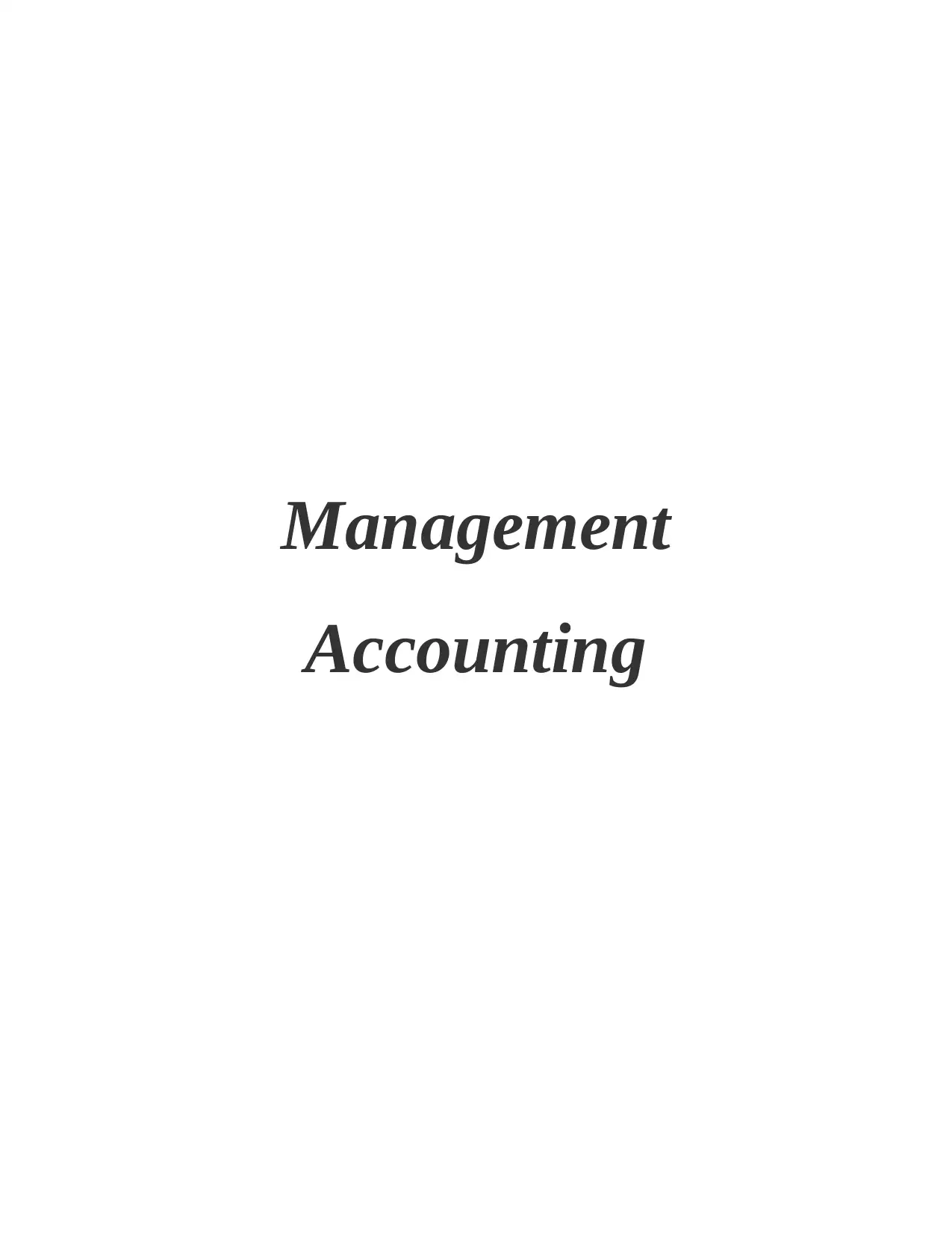
Management
Accounting
Accounting
Paraphrase This Document
Need a fresh take? Get an instant paraphrase of this document with our AI Paraphraser
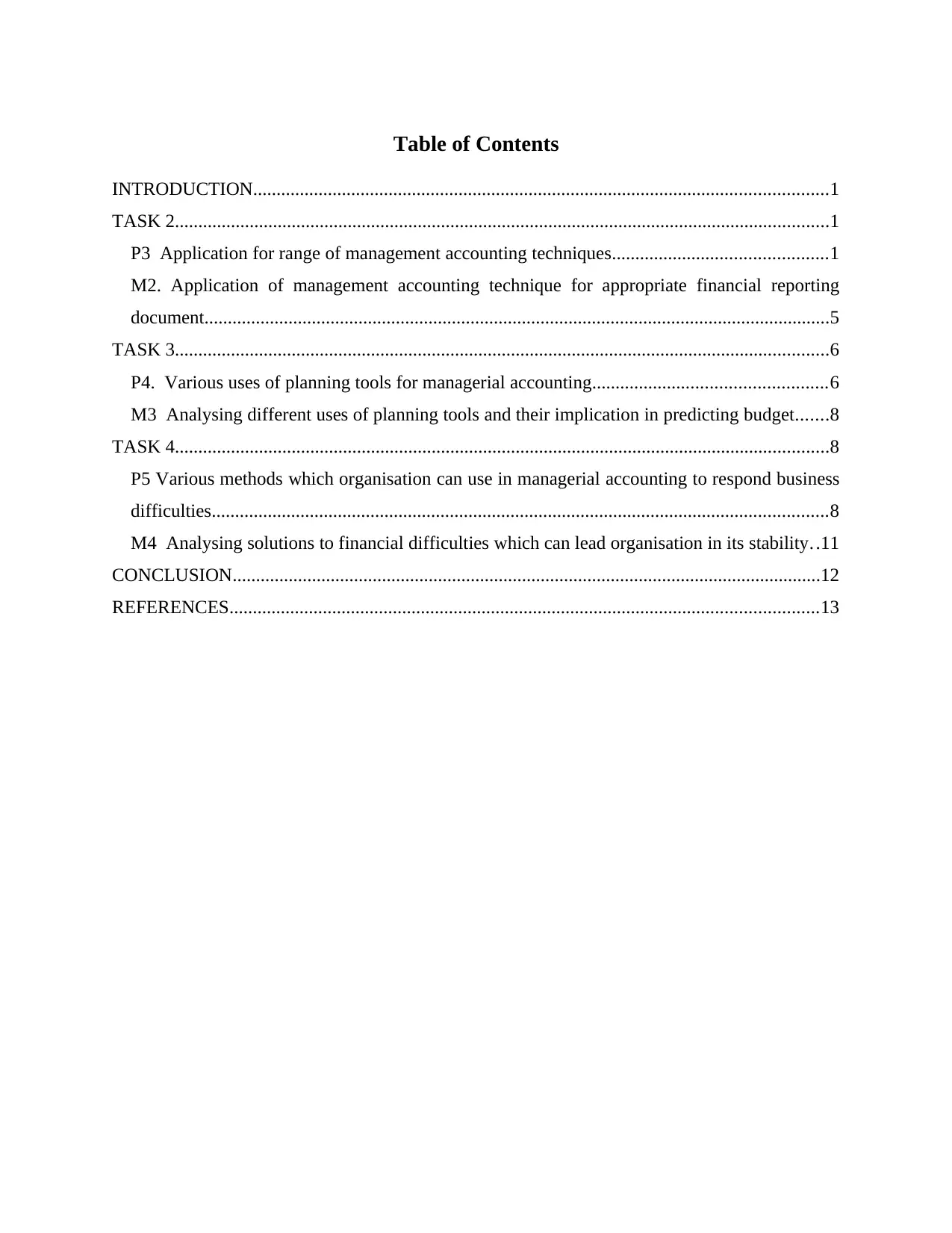
Table of Contents
INTRODUCTION...........................................................................................................................1
TASK 2............................................................................................................................................1
P3 Application for range of management accounting techniques..............................................1
M2. Application of management accounting technique for appropriate financial reporting
document......................................................................................................................................5
TASK 3............................................................................................................................................6
P4. Various uses of planning tools for managerial accounting..................................................6
M3 Analysing different uses of planning tools and their implication in predicting budget.......8
TASK 4............................................................................................................................................8
P5 Various methods which organisation can use in managerial accounting to respond business
difficulties....................................................................................................................................8
M4 Analysing solutions to financial difficulties which can lead organisation in its stability. .11
CONCLUSION..............................................................................................................................12
REFERENCES..............................................................................................................................13
INTRODUCTION...........................................................................................................................1
TASK 2............................................................................................................................................1
P3 Application for range of management accounting techniques..............................................1
M2. Application of management accounting technique for appropriate financial reporting
document......................................................................................................................................5
TASK 3............................................................................................................................................6
P4. Various uses of planning tools for managerial accounting..................................................6
M3 Analysing different uses of planning tools and their implication in predicting budget.......8
TASK 4............................................................................................................................................8
P5 Various methods which organisation can use in managerial accounting to respond business
difficulties....................................................................................................................................8
M4 Analysing solutions to financial difficulties which can lead organisation in its stability. .11
CONCLUSION..............................................................................................................................12
REFERENCES..............................................................................................................................13
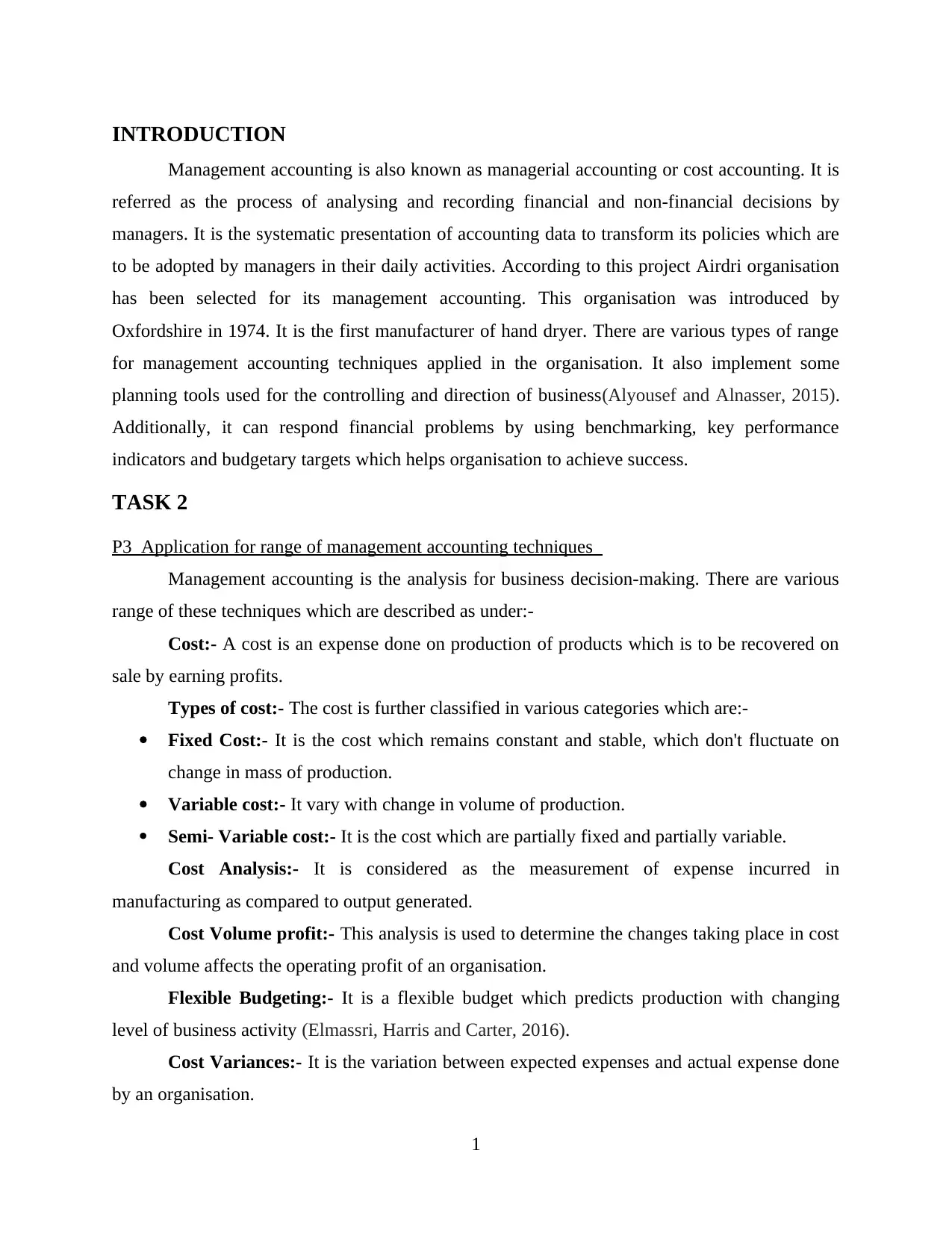
INTRODUCTION
Management accounting is also known as managerial accounting or cost accounting. It is
referred as the process of analysing and recording financial and non-financial decisions by
managers. It is the systematic presentation of accounting data to transform its policies which are
to be adopted by managers in their daily activities. According to this project Airdri organisation
has been selected for its management accounting. This organisation was introduced by
Oxfordshire in 1974. It is the first manufacturer of hand dryer. There are various types of range
for management accounting techniques applied in the organisation. It also implement some
planning tools used for the controlling and direction of business(Alyousef and Alnasser, 2015).
Additionally, it can respond financial problems by using benchmarking, key performance
indicators and budgetary targets which helps organisation to achieve success.
TASK 2
P3 Application for range of management accounting techniques
Management accounting is the analysis for business decision-making. There are various
range of these techniques which are described as under:-
Cost:- A cost is an expense done on production of products which is to be recovered on
sale by earning profits.
Types of cost:- The cost is further classified in various categories which are:-
Fixed Cost:- It is the cost which remains constant and stable, which don't fluctuate on
change in mass of production.
Variable cost:- It vary with change in volume of production.
Semi- Variable cost:- It is the cost which are partially fixed and partially variable.
Cost Analysis:- It is considered as the measurement of expense incurred in
manufacturing as compared to output generated.
Cost Volume profit:- This analysis is used to determine the changes taking place in cost
and volume affects the operating profit of an organisation.
Flexible Budgeting:- It is a flexible budget which predicts production with changing
level of business activity (Elmassri, Harris and Carter, 2016).
Cost Variances:- It is the variation between expected expenses and actual expense done
by an organisation.
1
Management accounting is also known as managerial accounting or cost accounting. It is
referred as the process of analysing and recording financial and non-financial decisions by
managers. It is the systematic presentation of accounting data to transform its policies which are
to be adopted by managers in their daily activities. According to this project Airdri organisation
has been selected for its management accounting. This organisation was introduced by
Oxfordshire in 1974. It is the first manufacturer of hand dryer. There are various types of range
for management accounting techniques applied in the organisation. It also implement some
planning tools used for the controlling and direction of business(Alyousef and Alnasser, 2015).
Additionally, it can respond financial problems by using benchmarking, key performance
indicators and budgetary targets which helps organisation to achieve success.
TASK 2
P3 Application for range of management accounting techniques
Management accounting is the analysis for business decision-making. There are various
range of these techniques which are described as under:-
Cost:- A cost is an expense done on production of products which is to be recovered on
sale by earning profits.
Types of cost:- The cost is further classified in various categories which are:-
Fixed Cost:- It is the cost which remains constant and stable, which don't fluctuate on
change in mass of production.
Variable cost:- It vary with change in volume of production.
Semi- Variable cost:- It is the cost which are partially fixed and partially variable.
Cost Analysis:- It is considered as the measurement of expense incurred in
manufacturing as compared to output generated.
Cost Volume profit:- This analysis is used to determine the changes taking place in cost
and volume affects the operating profit of an organisation.
Flexible Budgeting:- It is a flexible budget which predicts production with changing
level of business activity (Elmassri, Harris and Carter, 2016).
Cost Variances:- It is the variation between expected expenses and actual expense done
by an organisation.
1
⊘ This is a preview!⊘
Do you want full access?
Subscribe today to unlock all pages.

Trusted by 1+ million students worldwide
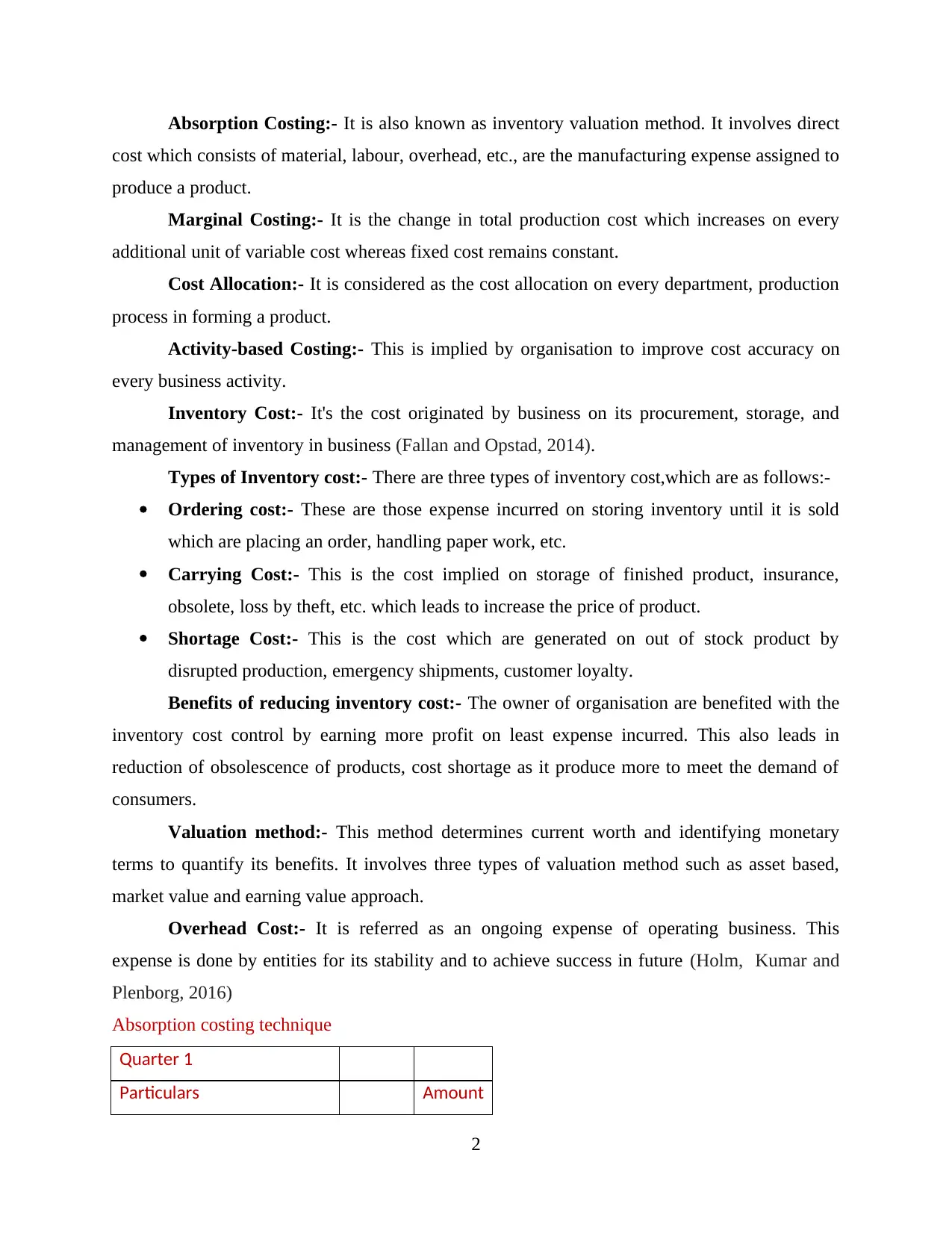
Absorption Costing:- It is also known as inventory valuation method. It involves direct
cost which consists of material, labour, overhead, etc., are the manufacturing expense assigned to
produce a product.
Marginal Costing:- It is the change in total production cost which increases on every
additional unit of variable cost whereas fixed cost remains constant.
Cost Allocation:- It is considered as the cost allocation on every department, production
process in forming a product.
Activity-based Costing:- This is implied by organisation to improve cost accuracy on
every business activity.
Inventory Cost:- It's the cost originated by business on its procurement, storage, and
management of inventory in business (Fallan and Opstad, 2014).
Types of Inventory cost:- There are three types of inventory cost,which are as follows:-
Ordering cost:- These are those expense incurred on storing inventory until it is sold
which are placing an order, handling paper work, etc.
Carrying Cost:- This is the cost implied on storage of finished product, insurance,
obsolete, loss by theft, etc. which leads to increase the price of product.
Shortage Cost:- This is the cost which are generated on out of stock product by
disrupted production, emergency shipments, customer loyalty.
Benefits of reducing inventory cost:- The owner of organisation are benefited with the
inventory cost control by earning more profit on least expense incurred. This also leads in
reduction of obsolescence of products, cost shortage as it produce more to meet the demand of
consumers.
Valuation method:- This method determines current worth and identifying monetary
terms to quantify its benefits. It involves three types of valuation method such as asset based,
market value and earning value approach.
Overhead Cost:- It is referred as an ongoing expense of operating business. This
expense is done by entities for its stability and to achieve success in future (Holm, Kumar and
Plenborg, 2016)
Absorption costing technique
Quarter 1
Particulars Amount
2
cost which consists of material, labour, overhead, etc., are the manufacturing expense assigned to
produce a product.
Marginal Costing:- It is the change in total production cost which increases on every
additional unit of variable cost whereas fixed cost remains constant.
Cost Allocation:- It is considered as the cost allocation on every department, production
process in forming a product.
Activity-based Costing:- This is implied by organisation to improve cost accuracy on
every business activity.
Inventory Cost:- It's the cost originated by business on its procurement, storage, and
management of inventory in business (Fallan and Opstad, 2014).
Types of Inventory cost:- There are three types of inventory cost,which are as follows:-
Ordering cost:- These are those expense incurred on storing inventory until it is sold
which are placing an order, handling paper work, etc.
Carrying Cost:- This is the cost implied on storage of finished product, insurance,
obsolete, loss by theft, etc. which leads to increase the price of product.
Shortage Cost:- This is the cost which are generated on out of stock product by
disrupted production, emergency shipments, customer loyalty.
Benefits of reducing inventory cost:- The owner of organisation are benefited with the
inventory cost control by earning more profit on least expense incurred. This also leads in
reduction of obsolescence of products, cost shortage as it produce more to meet the demand of
consumers.
Valuation method:- This method determines current worth and identifying monetary
terms to quantify its benefits. It involves three types of valuation method such as asset based,
market value and earning value approach.
Overhead Cost:- It is referred as an ongoing expense of operating business. This
expense is done by entities for its stability and to achieve success in future (Holm, Kumar and
Plenborg, 2016)
Absorption costing technique
Quarter 1
Particulars Amount
2
Paraphrase This Document
Need a fresh take? Get an instant paraphrase of this document with our AI Paraphraser
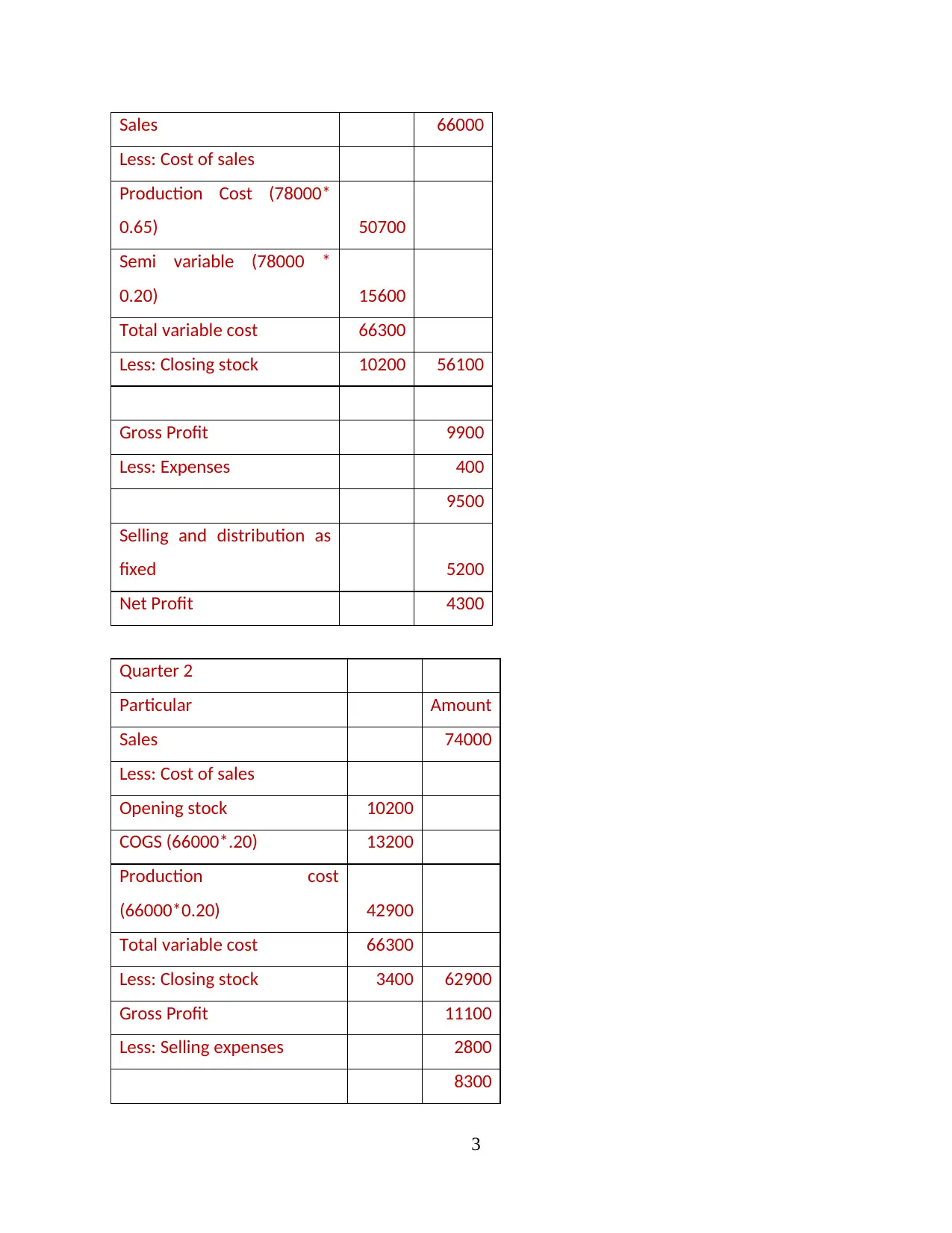
Sales 66000
Less: Cost of sales
Production Cost (78000*
0.65) 50700
Semi variable (78000 *
0.20) 15600
Total variable cost 66300
Less: Closing stock 10200 56100
Gross Profit 9900
Less: Expenses 400
9500
Selling and distribution as
fixed 5200
Net Profit 4300
Quarter 2
Particular Amount
Sales 74000
Less: Cost of sales
Opening stock 10200
COGS (66000*.20) 13200
Production cost
(66000*0.20) 42900
Total variable cost 66300
Less: Closing stock 3400 62900
Gross Profit 11100
Less: Selling expenses 2800
8300
3
Less: Cost of sales
Production Cost (78000*
0.65) 50700
Semi variable (78000 *
0.20) 15600
Total variable cost 66300
Less: Closing stock 10200 56100
Gross Profit 9900
Less: Expenses 400
9500
Selling and distribution as
fixed 5200
Net Profit 4300
Quarter 2
Particular Amount
Sales 74000
Less: Cost of sales
Opening stock 10200
COGS (66000*.20) 13200
Production cost
(66000*0.20) 42900
Total variable cost 66300
Less: Closing stock 3400 62900
Gross Profit 11100
Less: Selling expenses 2800
8300
3
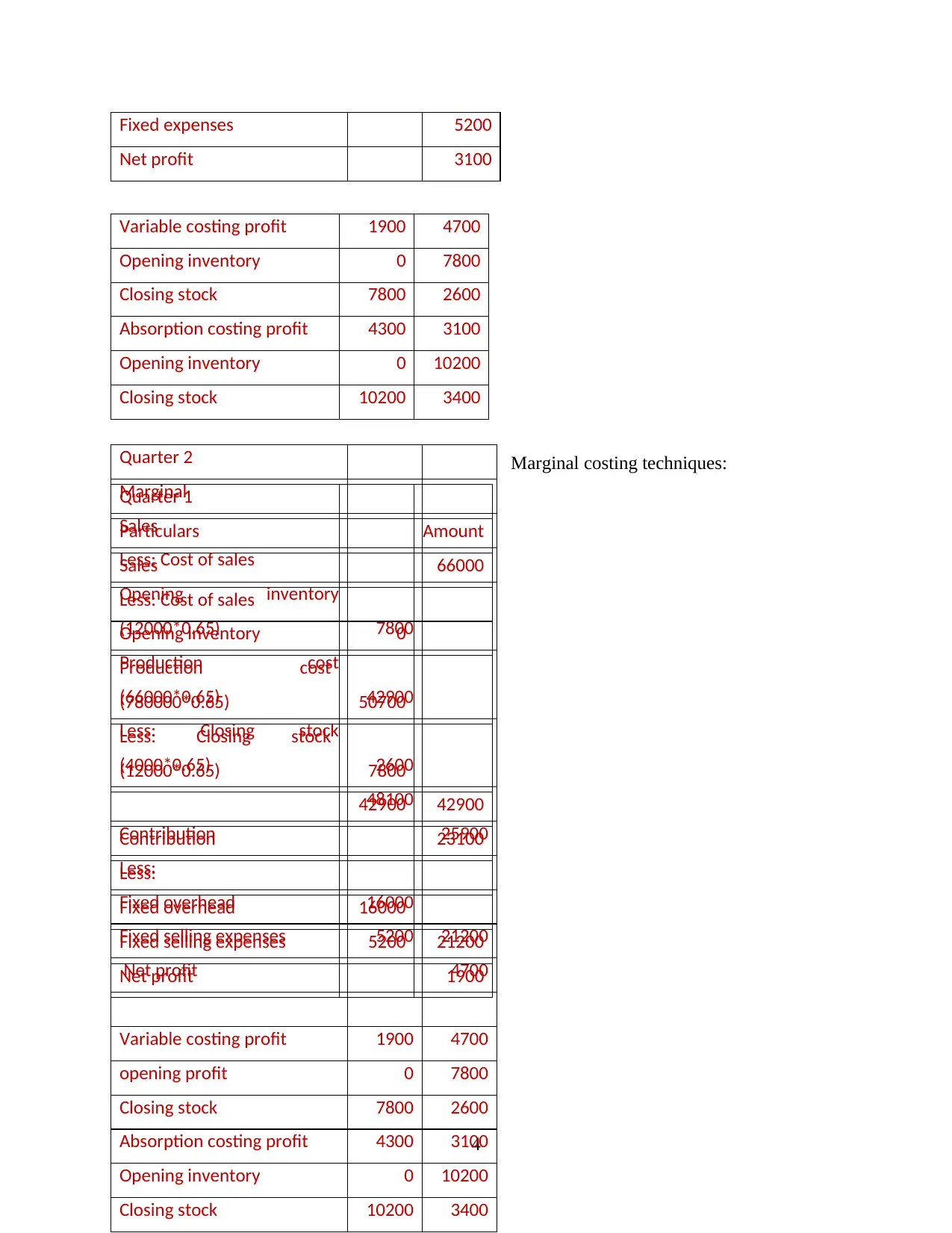
Fixed expenses 5200
Net profit 3100
Variable costing profit 1900 4700
Opening inventory 0 7800
Closing stock 7800 2600
Absorption costing profit 4300 3100
Opening inventory 0 10200
Closing stock 10200 3400
Marginal costing techniques:
Quarter 1
Particulars Amount
Sales 66000
Less: Cost of sales
Opening inventory 0
Production cost
(780000*0.65) 50700
Less: Closing stock
(12000*0.65) 7800
42900 42900
Contribution 23100
Less:
Fixed overhead 16000
Fixed selling expenses 5200 21200
Net profit 1900
4
Quarter 2
Marginal
Sales
Less: Cost of sales
Opening inventory
(12000*0.65) 7800
Production cost
(66000*0.65) 42900
Less: Closing stock
(4000*0.65) 2600
48100
Contribution 25900
Less:
Fixed overhead 16000
Fixed selling expenses 5200 21200
Net profit 4700
Variable costing profit 1900 4700
opening profit 0 7800
Closing stock 7800 2600
Absorption costing profit 4300 3100
Opening inventory 0 10200
Closing stock 10200 3400
Net profit 3100
Variable costing profit 1900 4700
Opening inventory 0 7800
Closing stock 7800 2600
Absorption costing profit 4300 3100
Opening inventory 0 10200
Closing stock 10200 3400
Marginal costing techniques:
Quarter 1
Particulars Amount
Sales 66000
Less: Cost of sales
Opening inventory 0
Production cost
(780000*0.65) 50700
Less: Closing stock
(12000*0.65) 7800
42900 42900
Contribution 23100
Less:
Fixed overhead 16000
Fixed selling expenses 5200 21200
Net profit 1900
4
Quarter 2
Marginal
Sales
Less: Cost of sales
Opening inventory
(12000*0.65) 7800
Production cost
(66000*0.65) 42900
Less: Closing stock
(4000*0.65) 2600
48100
Contribution 25900
Less:
Fixed overhead 16000
Fixed selling expenses 5200 21200
Net profit 4700
Variable costing profit 1900 4700
opening profit 0 7800
Closing stock 7800 2600
Absorption costing profit 4300 3100
Opening inventory 0 10200
Closing stock 10200 3400
⊘ This is a preview!⊘
Do you want full access?
Subscribe today to unlock all pages.

Trusted by 1+ million students worldwide
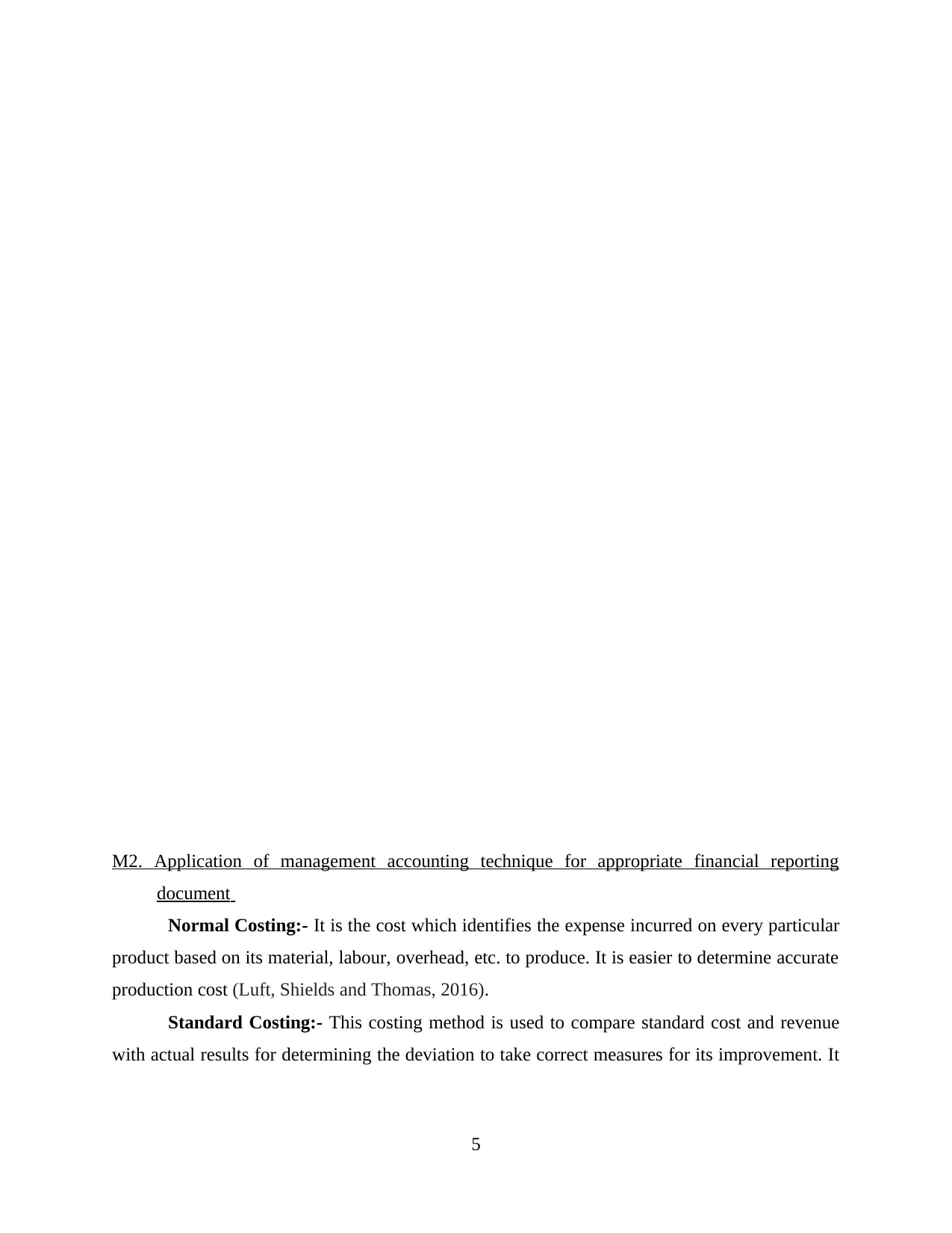
M2. Application of management accounting technique for appropriate financial reporting
document
Normal Costing:- It is the cost which identifies the expense incurred on every particular
product based on its material, labour, overhead, etc. to produce. It is easier to determine accurate
production cost (Luft, Shields and Thomas, 2016).
Standard Costing:- This costing method is used to compare standard cost and revenue
with actual results for determining the deviation to take correct measures for its improvement. It
5
document
Normal Costing:- It is the cost which identifies the expense incurred on every particular
product based on its material, labour, overhead, etc. to produce. It is easier to determine accurate
production cost (Luft, Shields and Thomas, 2016).
Standard Costing:- This costing method is used to compare standard cost and revenue
with actual results for determining the deviation to take correct measures for its improvement. It
5
Paraphrase This Document
Need a fresh take? Get an instant paraphrase of this document with our AI Paraphraser
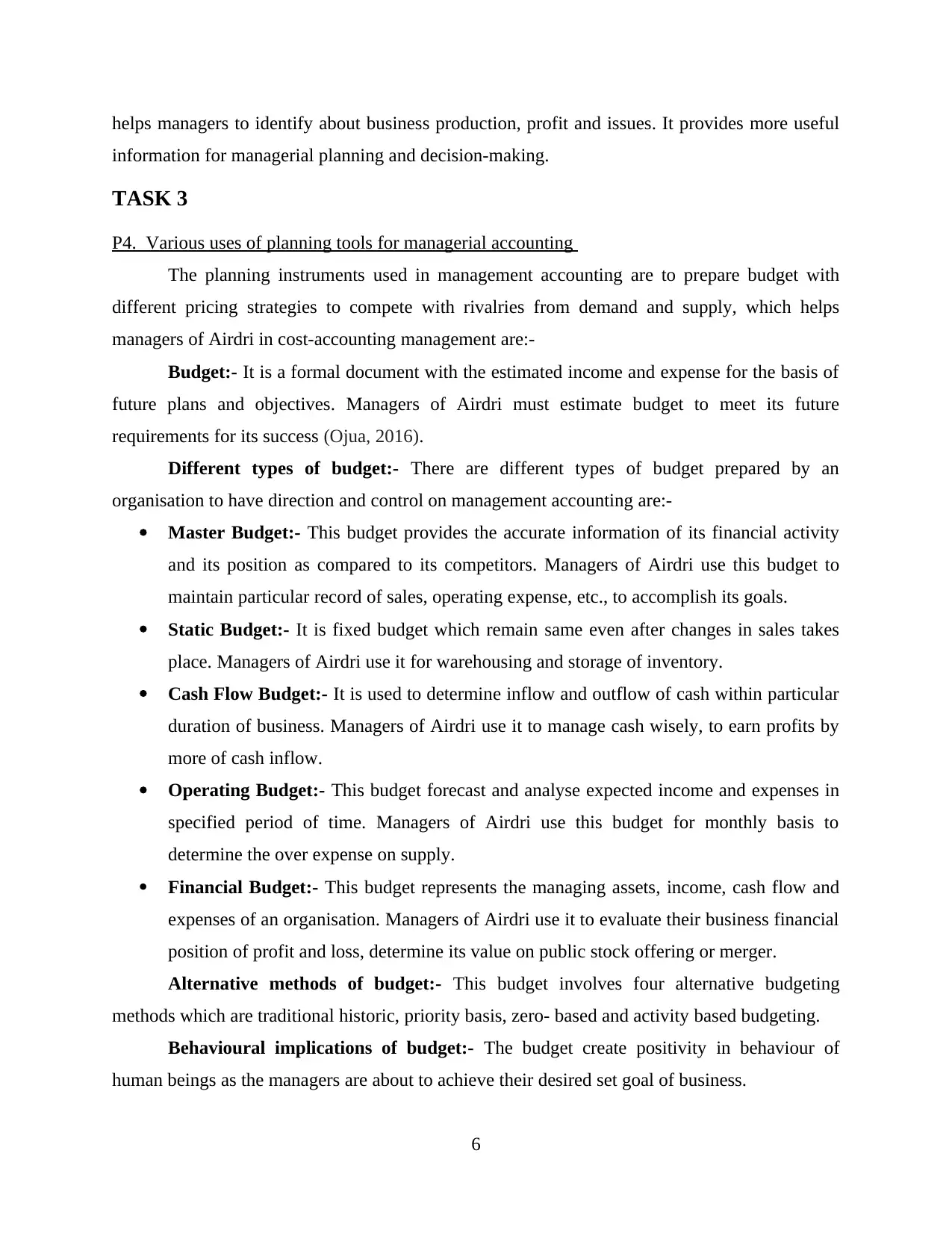
helps managers to identify about business production, profit and issues. It provides more useful
information for managerial planning and decision-making.
TASK 3
P4. Various uses of planning tools for managerial accounting
The planning instruments used in management accounting are to prepare budget with
different pricing strategies to compete with rivalries from demand and supply, which helps
managers of Airdri in cost-accounting management are:-
Budget:- It is a formal document with the estimated income and expense for the basis of
future plans and objectives. Managers of Airdri must estimate budget to meet its future
requirements for its success (Ojua, 2016).
Different types of budget:- There are different types of budget prepared by an
organisation to have direction and control on management accounting are:-
Master Budget:- This budget provides the accurate information of its financial activity
and its position as compared to its competitors. Managers of Airdri use this budget to
maintain particular record of sales, operating expense, etc., to accomplish its goals.
Static Budget:- It is fixed budget which remain same even after changes in sales takes
place. Managers of Airdri use it for warehousing and storage of inventory.
Cash Flow Budget:- It is used to determine inflow and outflow of cash within particular
duration of business. Managers of Airdri use it to manage cash wisely, to earn profits by
more of cash inflow.
Operating Budget:- This budget forecast and analyse expected income and expenses in
specified period of time. Managers of Airdri use this budget for monthly basis to
determine the over expense on supply.
Financial Budget:- This budget represents the managing assets, income, cash flow and
expenses of an organisation. Managers of Airdri use it to evaluate their business financial
position of profit and loss, determine its value on public stock offering or merger.
Alternative methods of budget:- This budget involves four alternative budgeting
methods which are traditional historic, priority basis, zero- based and activity based budgeting.
Behavioural implications of budget:- The budget create positivity in behaviour of
human beings as the managers are about to achieve their desired set goal of business.
6
information for managerial planning and decision-making.
TASK 3
P4. Various uses of planning tools for managerial accounting
The planning instruments used in management accounting are to prepare budget with
different pricing strategies to compete with rivalries from demand and supply, which helps
managers of Airdri in cost-accounting management are:-
Budget:- It is a formal document with the estimated income and expense for the basis of
future plans and objectives. Managers of Airdri must estimate budget to meet its future
requirements for its success (Ojua, 2016).
Different types of budget:- There are different types of budget prepared by an
organisation to have direction and control on management accounting are:-
Master Budget:- This budget provides the accurate information of its financial activity
and its position as compared to its competitors. Managers of Airdri use this budget to
maintain particular record of sales, operating expense, etc., to accomplish its goals.
Static Budget:- It is fixed budget which remain same even after changes in sales takes
place. Managers of Airdri use it for warehousing and storage of inventory.
Cash Flow Budget:- It is used to determine inflow and outflow of cash within particular
duration of business. Managers of Airdri use it to manage cash wisely, to earn profits by
more of cash inflow.
Operating Budget:- This budget forecast and analyse expected income and expenses in
specified period of time. Managers of Airdri use this budget for monthly basis to
determine the over expense on supply.
Financial Budget:- This budget represents the managing assets, income, cash flow and
expenses of an organisation. Managers of Airdri use it to evaluate their business financial
position of profit and loss, determine its value on public stock offering or merger.
Alternative methods of budget:- This budget involves four alternative budgeting
methods which are traditional historic, priority basis, zero- based and activity based budgeting.
Behavioural implications of budget:- The budget create positivity in behaviour of
human beings as the managers are about to achieve their desired set goal of business.
6
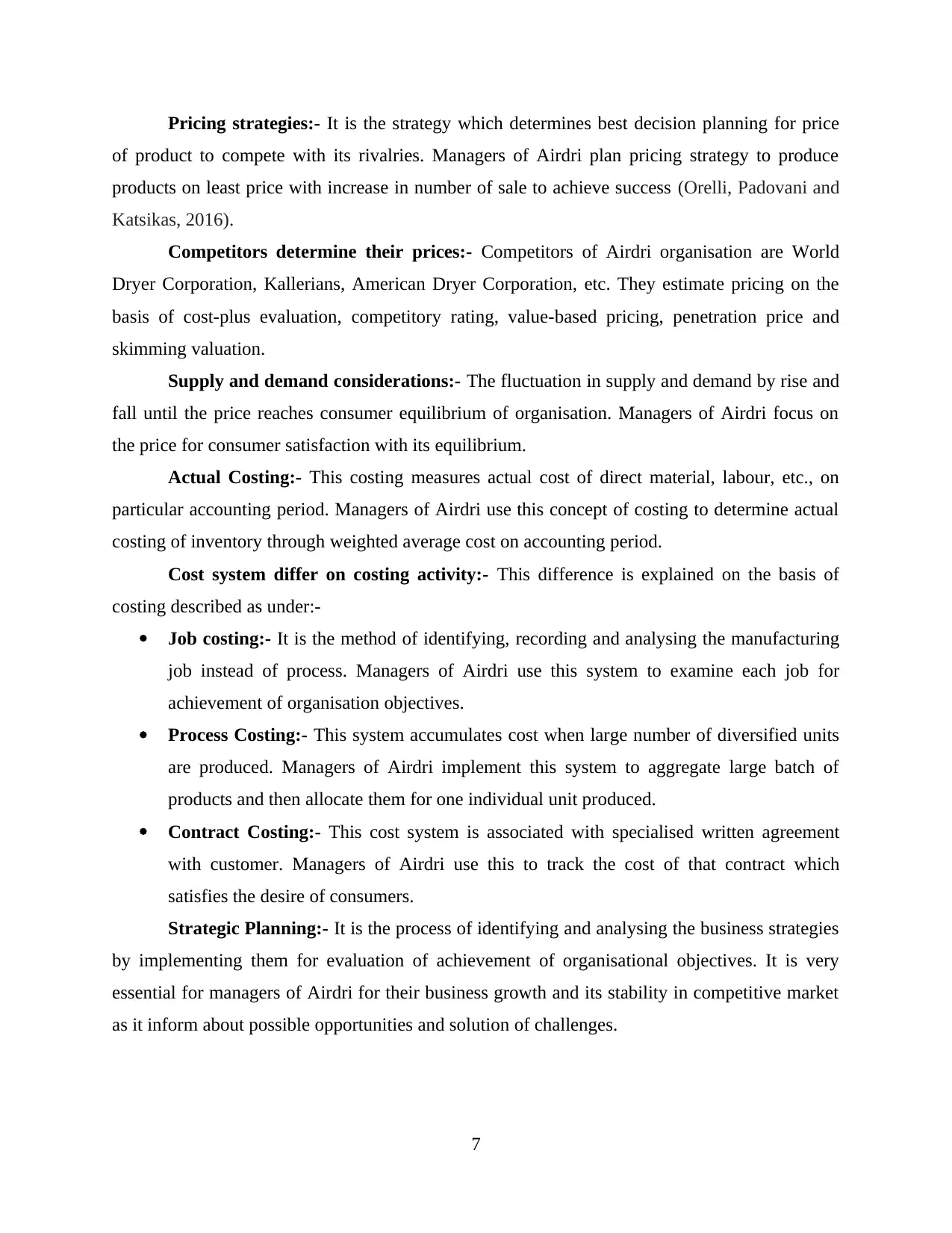
Pricing strategies:- It is the strategy which determines best decision planning for price
of product to compete with its rivalries. Managers of Airdri plan pricing strategy to produce
products on least price with increase in number of sale to achieve success (Orelli, Padovani and
Katsikas, 2016).
Competitors determine their prices:- Competitors of Airdri organisation are World
Dryer Corporation, Kallerians, American Dryer Corporation, etc. They estimate pricing on the
basis of cost-plus evaluation, competitory rating, value-based pricing, penetration price and
skimming valuation.
Supply and demand considerations:- The fluctuation in supply and demand by rise and
fall until the price reaches consumer equilibrium of organisation. Managers of Airdri focus on
the price for consumer satisfaction with its equilibrium.
Actual Costing:- This costing measures actual cost of direct material, labour, etc., on
particular accounting period. Managers of Airdri use this concept of costing to determine actual
costing of inventory through weighted average cost on accounting period.
Cost system differ on costing activity:- This difference is explained on the basis of
costing described as under:-
Job costing:- It is the method of identifying, recording and analysing the manufacturing
job instead of process. Managers of Airdri use this system to examine each job for
achievement of organisation objectives.
Process Costing:- This system accumulates cost when large number of diversified units
are produced. Managers of Airdri implement this system to aggregate large batch of
products and then allocate them for one individual unit produced.
Contract Costing:- This cost system is associated with specialised written agreement
with customer. Managers of Airdri use this to track the cost of that contract which
satisfies the desire of consumers.
Strategic Planning:- It is the process of identifying and analysing the business strategies
by implementing them for evaluation of achievement of organisational objectives. It is very
essential for managers of Airdri for their business growth and its stability in competitive market
as it inform about possible opportunities and solution of challenges.
7
of product to compete with its rivalries. Managers of Airdri plan pricing strategy to produce
products on least price with increase in number of sale to achieve success (Orelli, Padovani and
Katsikas, 2016).
Competitors determine their prices:- Competitors of Airdri organisation are World
Dryer Corporation, Kallerians, American Dryer Corporation, etc. They estimate pricing on the
basis of cost-plus evaluation, competitory rating, value-based pricing, penetration price and
skimming valuation.
Supply and demand considerations:- The fluctuation in supply and demand by rise and
fall until the price reaches consumer equilibrium of organisation. Managers of Airdri focus on
the price for consumer satisfaction with its equilibrium.
Actual Costing:- This costing measures actual cost of direct material, labour, etc., on
particular accounting period. Managers of Airdri use this concept of costing to determine actual
costing of inventory through weighted average cost on accounting period.
Cost system differ on costing activity:- This difference is explained on the basis of
costing described as under:-
Job costing:- It is the method of identifying, recording and analysing the manufacturing
job instead of process. Managers of Airdri use this system to examine each job for
achievement of organisation objectives.
Process Costing:- This system accumulates cost when large number of diversified units
are produced. Managers of Airdri implement this system to aggregate large batch of
products and then allocate them for one individual unit produced.
Contract Costing:- This cost system is associated with specialised written agreement
with customer. Managers of Airdri use this to track the cost of that contract which
satisfies the desire of consumers.
Strategic Planning:- It is the process of identifying and analysing the business strategies
by implementing them for evaluation of achievement of organisational objectives. It is very
essential for managers of Airdri for their business growth and its stability in competitive market
as it inform about possible opportunities and solution of challenges.
7
⊘ This is a preview!⊘
Do you want full access?
Subscribe today to unlock all pages.

Trusted by 1+ million students worldwide
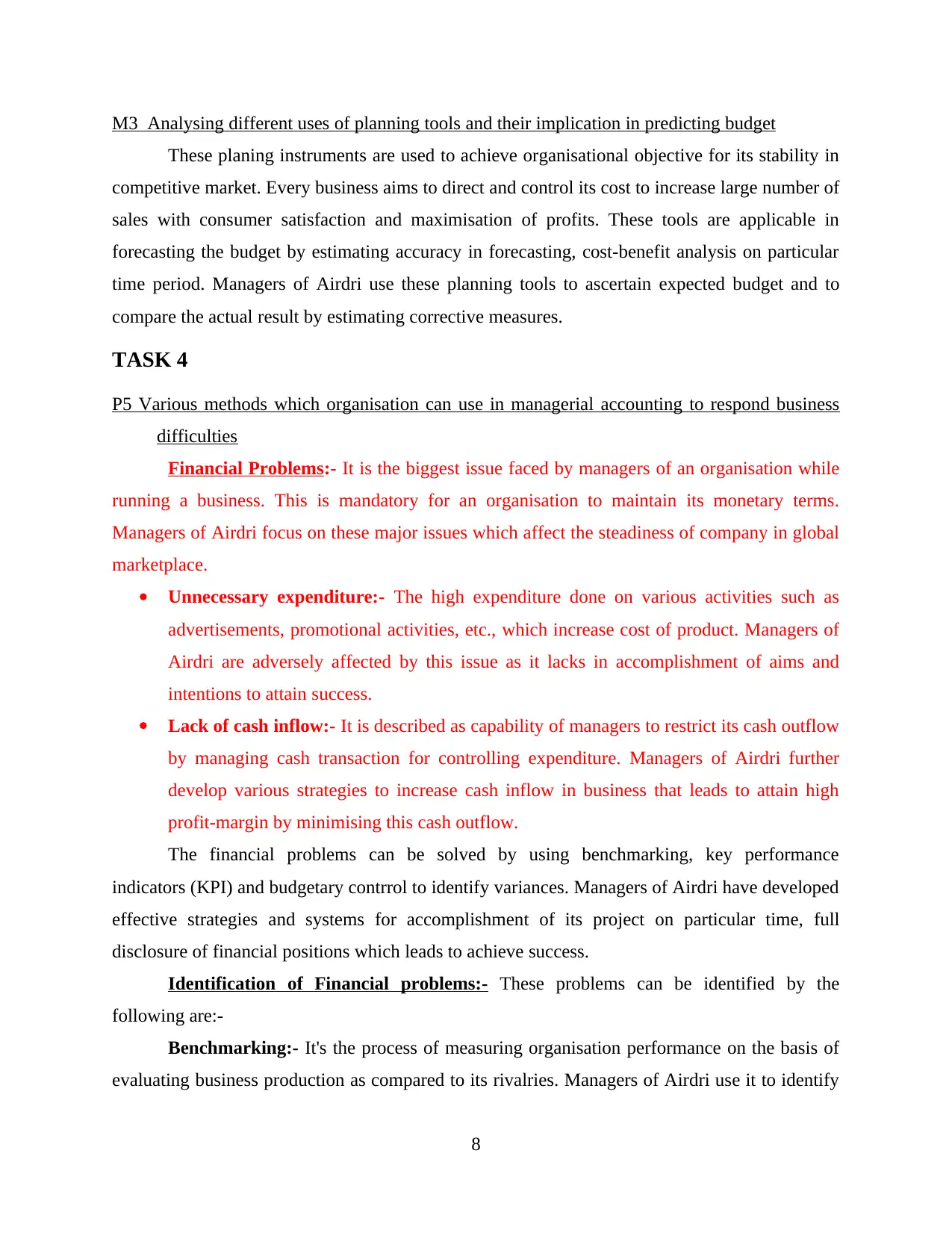
M3 Analysing different uses of planning tools and their implication in predicting budget
These planing instruments are used to achieve organisational objective for its stability in
competitive market. Every business aims to direct and control its cost to increase large number of
sales with consumer satisfaction and maximisation of profits. These tools are applicable in
forecasting the budget by estimating accuracy in forecasting, cost-benefit analysis on particular
time period. Managers of Airdri use these planning tools to ascertain expected budget and to
compare the actual result by estimating corrective measures.
TASK 4
P5 Various methods which organisation can use in managerial accounting to respond business
difficulties
Financial Problems:- It is the biggest issue faced by managers of an organisation while
running a business. This is mandatory for an organisation to maintain its monetary terms.
Managers of Airdri focus on these major issues which affect the steadiness of company in global
marketplace.
Unnecessary expenditure:- The high expenditure done on various activities such as
advertisements, promotional activities, etc., which increase cost of product. Managers of
Airdri are adversely affected by this issue as it lacks in accomplishment of aims and
intentions to attain success.
Lack of cash inflow:- It is described as capability of managers to restrict its cash outflow
by managing cash transaction for controlling expenditure. Managers of Airdri further
develop various strategies to increase cash inflow in business that leads to attain high
profit-margin by minimising this cash outflow.
The financial problems can be solved by using benchmarking, key performance
indicators (KPI) and budgetary contrrol to identify variances. Managers of Airdri have developed
effective strategies and systems for accomplishment of its project on particular time, full
disclosure of financial positions which leads to achieve success.
Identification of Financial problems:- These problems can be identified by the
following are:-
Benchmarking:- It's the process of measuring organisation performance on the basis of
evaluating business production as compared to its rivalries. Managers of Airdri use it to identify
8
These planing instruments are used to achieve organisational objective for its stability in
competitive market. Every business aims to direct and control its cost to increase large number of
sales with consumer satisfaction and maximisation of profits. These tools are applicable in
forecasting the budget by estimating accuracy in forecasting, cost-benefit analysis on particular
time period. Managers of Airdri use these planning tools to ascertain expected budget and to
compare the actual result by estimating corrective measures.
TASK 4
P5 Various methods which organisation can use in managerial accounting to respond business
difficulties
Financial Problems:- It is the biggest issue faced by managers of an organisation while
running a business. This is mandatory for an organisation to maintain its monetary terms.
Managers of Airdri focus on these major issues which affect the steadiness of company in global
marketplace.
Unnecessary expenditure:- The high expenditure done on various activities such as
advertisements, promotional activities, etc., which increase cost of product. Managers of
Airdri are adversely affected by this issue as it lacks in accomplishment of aims and
intentions to attain success.
Lack of cash inflow:- It is described as capability of managers to restrict its cash outflow
by managing cash transaction for controlling expenditure. Managers of Airdri further
develop various strategies to increase cash inflow in business that leads to attain high
profit-margin by minimising this cash outflow.
The financial problems can be solved by using benchmarking, key performance
indicators (KPI) and budgetary contrrol to identify variances. Managers of Airdri have developed
effective strategies and systems for accomplishment of its project on particular time, full
disclosure of financial positions which leads to achieve success.
Identification of Financial problems:- These problems can be identified by the
following are:-
Benchmarking:- It's the process of measuring organisation performance on the basis of
evaluating business production as compared to its rivalries. Managers of Airdri use it to identify
8
Paraphrase This Document
Need a fresh take? Get an instant paraphrase of this document with our AI Paraphraser
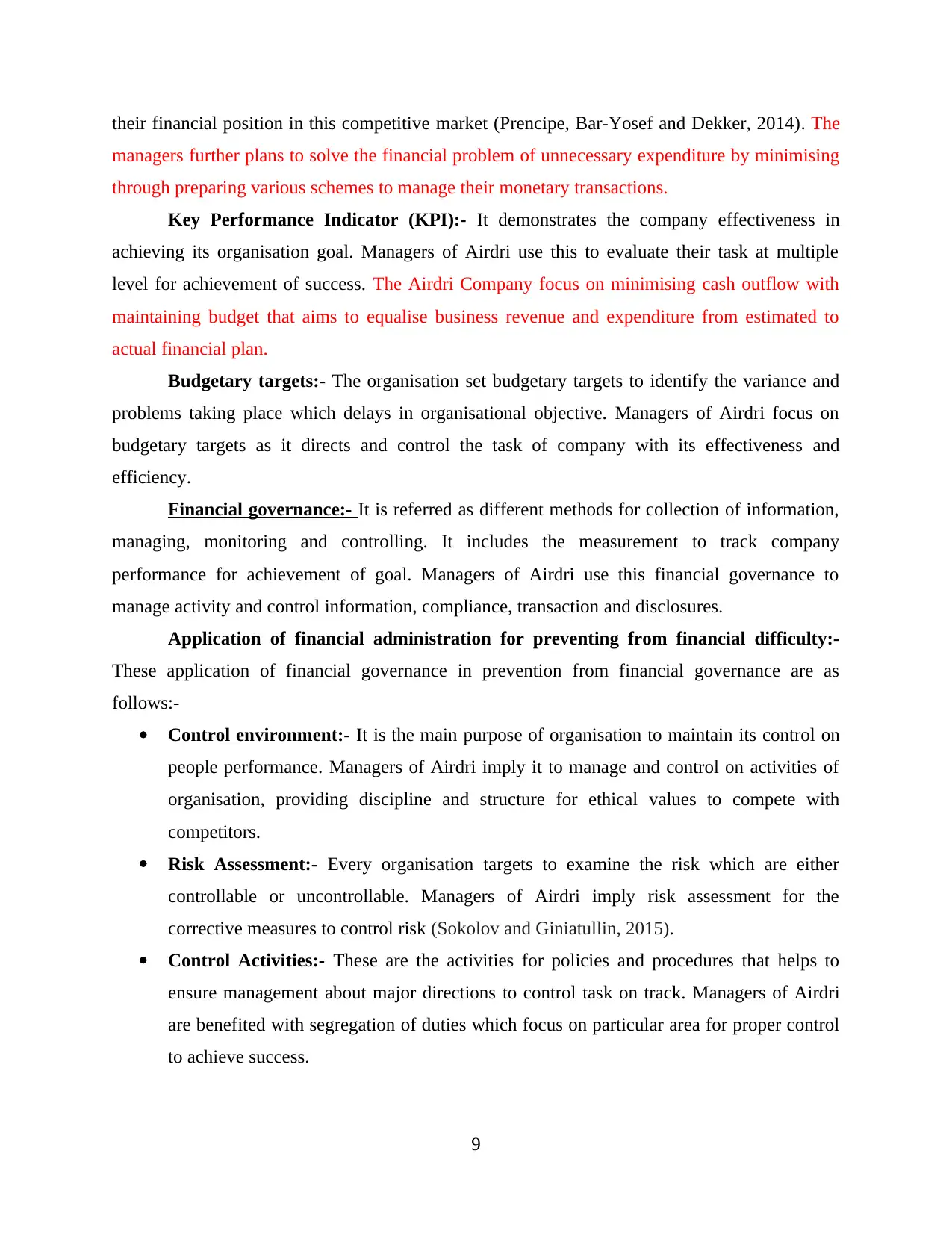
their financial position in this competitive market (Prencipe, Bar-Yosef and Dekker, 2014). The
managers further plans to solve the financial problem of unnecessary expenditure by minimising
through preparing various schemes to manage their monetary transactions.
Key Performance Indicator (KPI):- It demonstrates the company effectiveness in
achieving its organisation goal. Managers of Airdri use this to evaluate their task at multiple
level for achievement of success. The Airdri Company focus on minimising cash outflow with
maintaining budget that aims to equalise business revenue and expenditure from estimated to
actual financial plan.
Budgetary targets:- The organisation set budgetary targets to identify the variance and
problems taking place which delays in organisational objective. Managers of Airdri focus on
budgetary targets as it directs and control the task of company with its effectiveness and
efficiency.
Financial governance:- It is referred as different methods for collection of information,
managing, monitoring and controlling. It includes the measurement to track company
performance for achievement of goal. Managers of Airdri use this financial governance to
manage activity and control information, compliance, transaction and disclosures.
Application of financial administration for preventing from financial difficulty:-
These application of financial governance in prevention from financial governance are as
follows:-
Control environment:- It is the main purpose of organisation to maintain its control on
people performance. Managers of Airdri imply it to manage and control on activities of
organisation, providing discipline and structure for ethical values to compete with
competitors.
Risk Assessment:- Every organisation targets to examine the risk which are either
controllable or uncontrollable. Managers of Airdri imply risk assessment for the
corrective measures to control risk (Sokolov and Giniatullin, 2015).
Control Activities:- These are the activities for policies and procedures that helps to
ensure management about major directions to control task on track. Managers of Airdri
are benefited with segregation of duties which focus on particular area for proper control
to achieve success.
9
managers further plans to solve the financial problem of unnecessary expenditure by minimising
through preparing various schemes to manage their monetary transactions.
Key Performance Indicator (KPI):- It demonstrates the company effectiveness in
achieving its organisation goal. Managers of Airdri use this to evaluate their task at multiple
level for achievement of success. The Airdri Company focus on minimising cash outflow with
maintaining budget that aims to equalise business revenue and expenditure from estimated to
actual financial plan.
Budgetary targets:- The organisation set budgetary targets to identify the variance and
problems taking place which delays in organisational objective. Managers of Airdri focus on
budgetary targets as it directs and control the task of company with its effectiveness and
efficiency.
Financial governance:- It is referred as different methods for collection of information,
managing, monitoring and controlling. It includes the measurement to track company
performance for achievement of goal. Managers of Airdri use this financial governance to
manage activity and control information, compliance, transaction and disclosures.
Application of financial administration for preventing from financial difficulty:-
These application of financial governance in prevention from financial governance are as
follows:-
Control environment:- It is the main purpose of organisation to maintain its control on
people performance. Managers of Airdri imply it to manage and control on activities of
organisation, providing discipline and structure for ethical values to compete with
competitors.
Risk Assessment:- Every organisation targets to examine the risk which are either
controllable or uncontrollable. Managers of Airdri imply risk assessment for the
corrective measures to control risk (Sokolov and Giniatullin, 2015).
Control Activities:- These are the activities for policies and procedures that helps to
ensure management about major directions to control task on track. Managers of Airdri
are benefited with segregation of duties which focus on particular area for proper control
to achieve success.
9
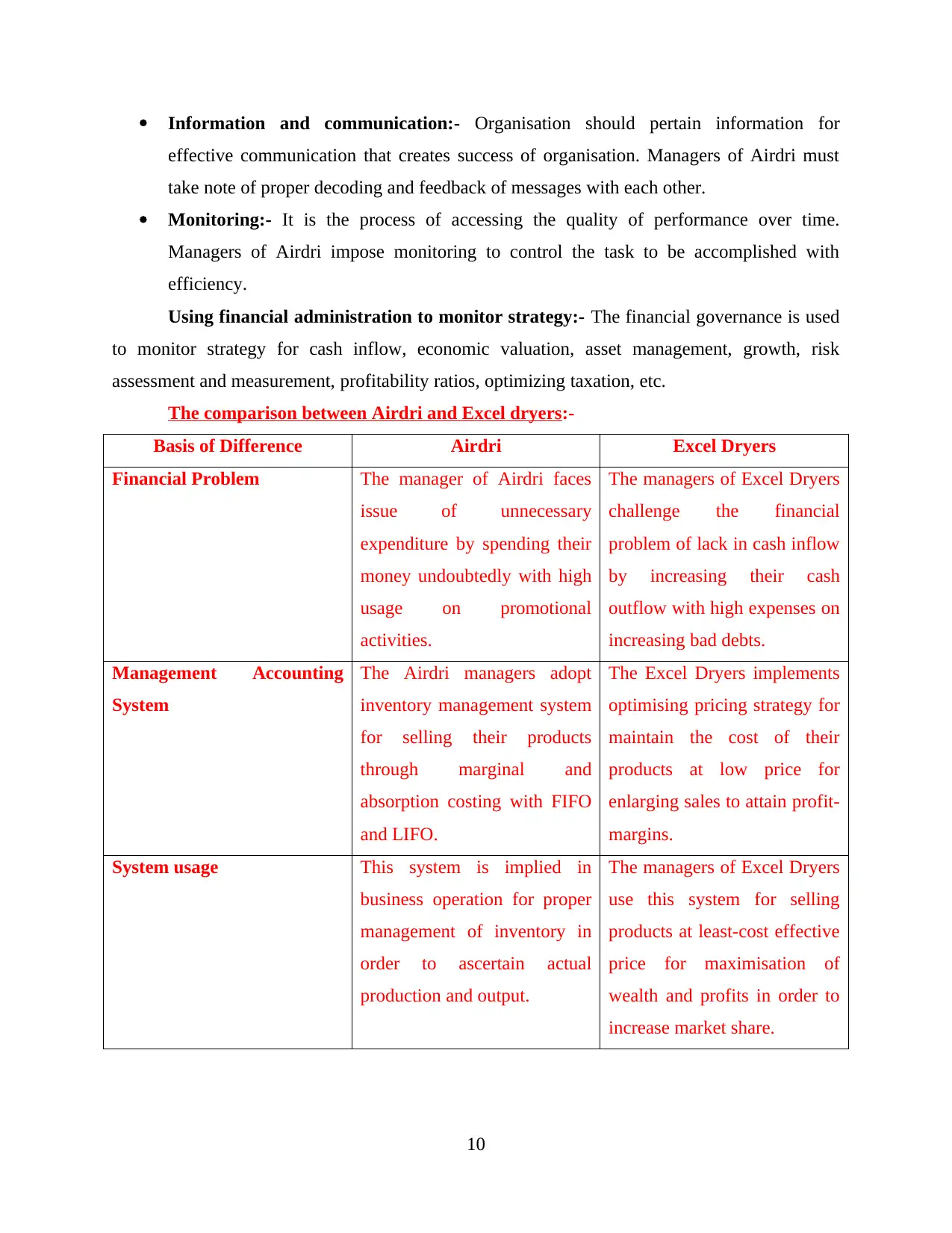
Information and communication:- Organisation should pertain information for
effective communication that creates success of organisation. Managers of Airdri must
take note of proper decoding and feedback of messages with each other.
Monitoring:- It is the process of accessing the quality of performance over time.
Managers of Airdri impose monitoring to control the task to be accomplished with
efficiency.
Using financial administration to monitor strategy:- The financial governance is used
to monitor strategy for cash inflow, economic valuation, asset management, growth, risk
assessment and measurement, profitability ratios, optimizing taxation, etc.
The comparison between Airdri and Excel dryers:-
Basis of Difference Airdri Excel Dryers
Financial Problem The manager of Airdri faces
issue of unnecessary
expenditure by spending their
money undoubtedly with high
usage on promotional
activities.
The managers of Excel Dryers
challenge the financial
problem of lack in cash inflow
by increasing their cash
outflow with high expenses on
increasing bad debts.
Management Accounting
System
The Airdri managers adopt
inventory management system
for selling their products
through marginal and
absorption costing with FIFO
and LIFO.
The Excel Dryers implements
optimising pricing strategy for
maintain the cost of their
products at low price for
enlarging sales to attain profit-
margins.
System usage This system is implied in
business operation for proper
management of inventory in
order to ascertain actual
production and output.
The managers of Excel Dryers
use this system for selling
products at least-cost effective
price for maximisation of
wealth and profits in order to
increase market share.
10
effective communication that creates success of organisation. Managers of Airdri must
take note of proper decoding and feedback of messages with each other.
Monitoring:- It is the process of accessing the quality of performance over time.
Managers of Airdri impose monitoring to control the task to be accomplished with
efficiency.
Using financial administration to monitor strategy:- The financial governance is used
to monitor strategy for cash inflow, economic valuation, asset management, growth, risk
assessment and measurement, profitability ratios, optimizing taxation, etc.
The comparison between Airdri and Excel dryers:-
Basis of Difference Airdri Excel Dryers
Financial Problem The manager of Airdri faces
issue of unnecessary
expenditure by spending their
money undoubtedly with high
usage on promotional
activities.
The managers of Excel Dryers
challenge the financial
problem of lack in cash inflow
by increasing their cash
outflow with high expenses on
increasing bad debts.
Management Accounting
System
The Airdri managers adopt
inventory management system
for selling their products
through marginal and
absorption costing with FIFO
and LIFO.
The Excel Dryers implements
optimising pricing strategy for
maintain the cost of their
products at low price for
enlarging sales to attain profit-
margins.
System usage This system is implied in
business operation for proper
management of inventory in
order to ascertain actual
production and output.
The managers of Excel Dryers
use this system for selling
products at least-cost effective
price for maximisation of
wealth and profits in order to
increase market share.
10
⊘ This is a preview!⊘
Do you want full access?
Subscribe today to unlock all pages.

Trusted by 1+ million students worldwide
1 out of 15
Related Documents
Your All-in-One AI-Powered Toolkit for Academic Success.
+13062052269
info@desklib.com
Available 24*7 on WhatsApp / Email
![[object Object]](/_next/static/media/star-bottom.7253800d.svg)
Unlock your academic potential
Copyright © 2020–2025 A2Z Services. All Rights Reserved. Developed and managed by ZUCOL.





